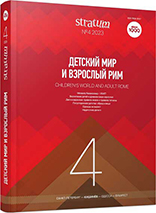Тульский феномен: новые находки позднеримских бронзовых монет с правобережья верхней Оки
Tula Phenomenon: New Finds of the Late Roman Bronze Coins from the Right Bank of the Upper Oka
Author(s): Alexey M. VorontsovSubject(s): History, Archaeology
Published by: Издательский дом Stratum, Университет «Высшая антропологическая школа»
Keywords: Late Roman Bronze Coins; Great Migration Period; Oka–Don watershed; sites of Krivoluch’e type; Moshchino culture; sites of Chertovickoe-Zamyatino type
Summary/Abstract: The article publishes new finds of Late Roman bronze coins from the Right Bank of the Upper Oka area, including the largest known today hoard from Rozhdestveno 1 settlement, consisting of 140 coins.The finds are represented in small coin denominations (АЕ3, АЕ4) and include emissions issued in the period between the reigns of Constantine the Great and the Theodosian dynasty rulers at mints of the eastern part of the Roman Empire (with the prevalence of Antioch production). The analysis of hoards’ chronological structure shows the quantitative prevalence of coins dating back to the Constantinian dynasty (306—363) and the Theodosian dynasty (379—457); coins of the Valentinian dynasty (364—392) are rare and single. Tula finds have a very similar chronological structure to the coin finds from the Seim River basin (the L’gov-Fatezh site’s group).The appearance of these finds in Tula region is connected with a group of sites of the Krivoluch’e type (mid-4th — 5th c.). Hoards and single finds are connected not only with this site group but also with surrounding settlements of the Moshchino culture.
Journal: Stratum plus. Археология и культурная антропология
- Issue Year: 2023
- Issue No: 4
- Page Range: 387-408
- Page Count: 22
- Language: Russian

